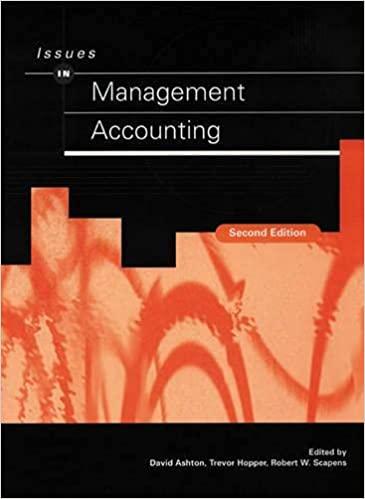Question
7) Boston Company sells thirty items for $800 per unit and has a cost of goods sold per unit of $480. The gross profit to
7) Boston Company sells thirty items for $800 per unit and has a cost of goods sold per unit of $480. The gross profit to be reported for selling 30 items is:
A) $320.
B) $9,600.
C) $14,400.
D) $24,000.
8) Sanfran Company purchased inventory for $110,000. In addition they had purchase returns of $6,000 and paid freight-in of $13,000. Sanfran Company's net cost of purchases would be:
A) $91,000.
B) $103,000.
C) $117,000.
D) $129,000.
9) Grogan Company purchases inventory on account with a cost of $1,700 and a retail price of $3,400. Grogan Company uses the perpetual inventory method. What journal entry is required on the date of purchase?
A) debit Purchases for $1,700 and credit Accounts Payable for $1,700
B) debit Purchases for $3,400 and credit Cash for $3,400
C) debit Inventory for $1,700 and credit Accounts Payable for $1,700
D) debit Accounts Receivable for $3,400 and credit Purchases for $3,400
10) On June 1, Nicholson Company purchased inventory on account with a cost of $1,600. Credit terms were 2/10, net 30. On June 2, Nicholson Company returned 50 percent of the inventory. Nicholson Company uses the perpetual inventory system. What journal entry did Nicholson Company prepare on June 2?
A) debit Purchase Returns for $1,600 and credit Accounts Payable for $1,600
B) debit Cash for $1,600 and credit Accounts Payable for $1,600
C) debit Purchase Returns for $800 and credit Accounts Payable for $800
D) debit Accounts Payable for $800 and credit Inventory for $800
11) When comparing the FIFO and LIFO inventory methods:
A) LIFO reports inventory at net realizable value.
B) LIFO reports the most up-to-date inventory cost on the balance sheet.
C) FIFO results in the most realistic net income figure.
D) FIFO matches old inventory costs against revenue.
12) A LIFO liquidation occurs when ________ fall(s) below the ending inventory quantities in the previous period.
A) beginning inventory quantities
B) ending inventory quantities
C) beginning inventory costs
D) ending inventory retail value
13) A company has a beginning inventory of $20,000 and purchases during the year of $140,000. The beginning inventory consisted of 2,000 units and 7,000 units were purchased during the year. The company has 5,000 units left at year-end. Under average-cost, what is Cost of Goods Sold? (Round any intermediary calculations to two decimal places and your final answer to the nearest dollar.)
A) $124,460
B) $71,120
C) $140,000
D) $160,000
14) A company has a beginning inventory of $50,000 and purchases during the year of $150,000. The beginning inventory consisted of 3,000 units and 8,000 units were purchased during the year. 3,780 units remain in ending inventory. The cost of the ending inventory using the average-cost method will be: (Round any intermediary calculations to two decimal places and your final answer to the nearest dollar.)
A) $131,260.
B) $199,980.
C) $68,720.
D) $268,700.
15) Perfect Catering Company's ending inventory was $103,700 at historical cost and $116,500 at current replacement cost. The company uses LIFO. Before consideration of the lower-of-cost-or-market rule, the company's cost of goods sold was $58,000. Following U.S. GAAP, which of the following statements reflect the correct application of the lower-of-cost-or-market rule?
A) The Ending Inventory balance will be $103,700, and Cost of Goods Sold will be $58,000.
B) The Ending Inventory balance will be $116,500, and Cost of Goods Sold will be $58,000.
C) The Ending Inventory balance will be $116,500, and Cost of Goods Sold will be $70,800.
D) The Ending Inventory balance will be $116,500, and Cost of Goods Sold will be $45,200.
16) Mariah Company has inventory at the end of the year with a historical cost of $73,000. Mariah Company uses the perpetual inventory system. Under the LCM rule, the current replacement cost is $70,600. The company uses LIFO. Under U.S. GAAP, the journal entry to record the write-down to LCM will:
A) debit Cost of Goods Sold for $2,400 and credit Inventory for $2,400.
B) debit Cost of Goods Sold for $2,400 and credit Purchases for $2,400.
C) debit Inventory for $2,400 and credit Cost of Goods Sold for $2,400.
D) debit Purchases for $2,400 and credit Cost of Goods Sold for $2,400.
17) The historical cost of Jahn Company's ending inventory was less than the net realizable value. The company uses FIFO. Following U.S. GAAP, which journal entry is required?
A) debit Cost of Goods Sold and credit Sales
B) debit Inventory and credit Cost of Goods Sold
C) debit Cost of Goods Sold and credit Inventory
D) No journal entry is needed.
18) Uptown Department Store uses the perpetual inventory system and has ending inventory with a historical cost of $610,000. The current replacement cost of the inventory is $598,000. The net realizable value is $670,000. The company uses LIFO. Before any adjustments at the end of the period, the cost of goods sold account has a balance of $930,000. Which journal entry is required under U.S. GAAP?
A) debit Cost of Goods Sold for $60,000 and credit Inventory for $60,000
B) debit Inventory for $60,000 and credit Cost of Goods Sold for $60,000
C) debit Cost of Goods Sold for $12,000 and credit Inventory for $12,000
D) debit Inventory for $12,000 and credit Cost of Goods Sold for $12,000
Step by Step Solution
There are 3 Steps involved in it
Step: 1

Get Instant Access to Expert-Tailored Solutions
See step-by-step solutions with expert insights and AI powered tools for academic success
Step: 2

Step: 3

Ace Your Homework with AI
Get the answers you need in no time with our AI-driven, step-by-step assistance
Get Started


